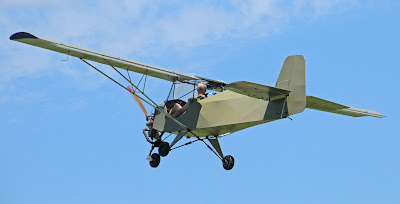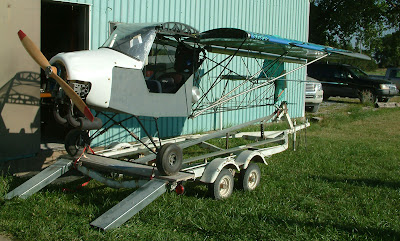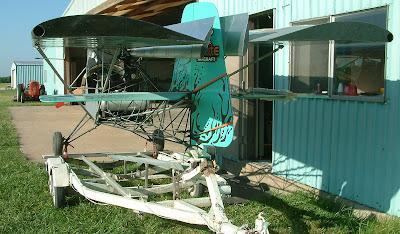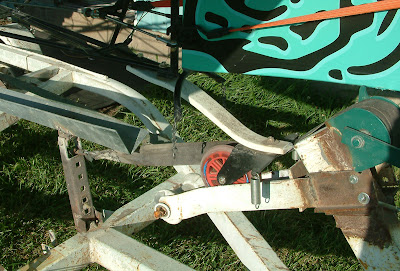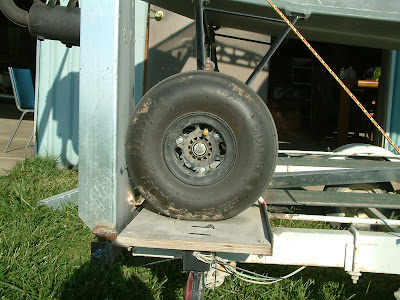Oshkosh preparations have been running us 7/24. We've been preparing 3 ships for Oshkosh Airventure; on top of that we just completed a customer delivery and we have another which we won't get done before Osh. (But we wanted to.) And on top of all that is our 'secret ops' which are preparing some major whammy to talk about at Osh.
But never mind that. Time to write a blog post...
Please back up about 15 years in my life.... to a memory from my past.
I was heading to Denver, Colorado to attend a "Promise Keeper" event. I had arranged to rent a retractable Piper Arrow, which boasted a 180HP engine, good range, and a useful load of about 850 pounds. The owner of the airplane affectionately called her 'Amy Arrow'.
It was hot in the summertime; we landed at Centennial airport without issues. The Promise Keepers event was soon over, and we headed back to Centennial for the flight home. I had myself and 2 friends on board, (or, as I liked to say when I filed a flight plan, 3 souls on board).
I had filled the tanks for the flight home. I had also carefully reviewed the flight manual: the flight manual called for 25 degrees of flaps in order to produce a short ground roll. I dialed in 25 degrees, per the manual. (Very stupid... as you shall soon see.) Our plane was exactly at gross weight. Density altitude was somewhere around 8500+ feet. That shouldn't be a problem with an airplane that had a service ceiling well over 13,000 feet... right?!
We were cleared for takeoff at Centennial.
I advanced the throttle, and Amy Arrow started to move down the runway. Slowly.
Somewhere around 3 or 4 thousand feet down the runway, I started to pull back on the elevator. Amy dutifully rose about 8 feet above the ground.
And stayed there. 5000 feet of runway remaining.
And stayed there. 4000 feet of runway remaining.
And stayed there. 3000 feet of runway remaining.
And stayed there. 2000 feet of runway remaining.
And stayed there. Still 8 feet off the ground, 1000 feet of runway remaining.
I refused to set it back down and abort the takeoff. Why? More youthful piloting stupidity.
I saw a ridgeline off in the distance, straight ahead. That was a problem. I would hit it.
I saw a descending valley off to the left. If I turned that way, I would have terrain descend, thus improving my relative altitude to the ground.
I slightly turned to the left.
I realized I was hovering over the ground... the plane would not climb. I had two opportunities to reduce drag: Get the gear up. Reduce flaps. I also realized that if I rapidly retracted flaps, the plane would immediately settle to the ground. First things first... I retracted the landing gear.
Then, I grabbed the manual flap handle, and s l o w l y went from 25 degrees, to 20, then to 15, then to 10 degrees of flaps, then to five, then to zero. The plane seemed to stop mushing over the ground.
We flew over a golf course. Since the terrain was descending, and we were now probably climbing at 50 feet per minute, we had perhaps 150 feet of altitude over the course. Some golfers looked up at this strange sight of an airplane, so close to the ground, passing over to them.
And then I realized that the plane had perhaps 250 feet of the ground, and that positive climb was definitely occurring. We would be okay.
And then I realized something else was occuring: the tower at Centennial was talking to me. I hadn't heard them, because the crisis had shut down that part of the brain that listens to outside voices.
"are you OK.... are you OK... are you OK..." I could also hear our N number, recited over and over.
"Yes, I'm OK".
They couldn't see me: my plane had turned left and disappeared below their horizon.
I soon cancelled flight following and headed home for Wichita. I kept wondering what my passengers were thinking: had I just nearly killed them?
Here is my list of stupidities:
A) Dialing in 25 degrees of flaps is great for reducing ground roll, but does not improve Vy. In fact, it has the opposite effect. You can't climb with 25 degrees of flaps in a 180HP Piper Arrow.
B) Density altitude is a killer. A non-turboed Arrow is a horrible climber in high DAs.
C) Flying at gross weight in high DAs is also a killer.
D) Lean the engine!
E) And most importantly: aborting the takeoff. I had multiple opportunities to abort and I did not do so.
As Flying magazine says, Never Again.
Tuesday, July 20, 2010
Friday, July 9, 2010
Belite Trike test flight
Here's a series of photos of a FAR Part 103 Ultralight Aircraft: the Belite Trike, in test flight, preparing for customer delivery. There's no cowl on this plane (yet) but the olive drab paint scheme looks sharp, and will be great as a base of a military paint scheme.
The plane flew absolutely wonderfully. Performance exceeded my expectations with a 28HP Hirth engine.
Plane is ready for delivery and should be on the truck next week, heading to a customer out of state.
Tuesday, July 6, 2010
Wichita Machinists, Disc Brakes, and Part 103 Ultralight Aircraft
Wichita, KS is the home of Belite Aircraft and also the Aircraft Capital of the World!
As home to a majority of general aviation aircraft (EG: Cessna, Beechcraft/Hawker, Bombardier/Learjet, also Spirit Aerosystems and Boeing Military) with notable exceptions of Cirrus and Piper, Wichita has a diverse manufacturing community. In particular, there are hundreds of small, medium, and large businesses which provide components to the major aviation companies.
Many (but not all) of those companies have been hurt badly by the aviation slowdown of the last couple of years.
This has been an opportunity for Belite: we've been able to find a machine shop or two who are capable of providing us with very high quality machined parts for our Belite Part 103 ultralight aircraft.
And tonight, I provide just one example: our new disc brakes, which we are installing on our ready to fly and kit aircraft. These disc brakes are composed of three major components: a machined 'tripod' standoff, which works in conjunction with a solid steel 4130 chromalloy axle to attach to the brake rotor and to the wheel; a brake attachment plate, and, of course, a disc brake caliper/rotor assembly, which comes directly from the mountain bike industry as an OEM component. It works great for our lightweight aircraft.
Here's what the assembled brake looks like (the brake cable is not attached in this photo) (also note the steel spring suspension):
It's a very tight, neat looking arrangement.
The aluminum components are machined from solid billet: 6061T-6, which is a common aircraft alloy.
Let's take a look at each individual component. Here's the standoff 'tripod':
And here's two more views of the same part:
This 'tripod is used to fix the brake caliper to the wheel. It's designed to work with our 5 inch wheels, which are now the standard wheel on every Belite aircraft.
Another component is the brake attachment plate. It's a simple part, and is very strong. Here it is:
To make all of this work, we do need a disc brake rotor and caliper. As I mentioned previously, our Part 103 ultralight aircraft are well matched to use a brake from Avid. Here's the brake:
So let's stack all these parts up and see what it looks like. You can see the 'Tripod' below the brake rotor:
And let's now put the attachment plate on top:
Obviously a few nuts, bolts, axles, and cables missing. But hopefully, you get the idea.
Here's one more look at how it ends up on the aircraft landing gear:
Side note: Look at that nice big fat 5.00 x 5 tire!
We sell these for $350 as a kit and $400 installed on our flyaway airplanes. The kit includes left and right sides. (pricing always subject to change without warning.)
You can find them on our Ready To Fly spreadsheet, and also on our Price Your Own Kit spreadsheet.
My thanks to my able assistant Gene Stratton for shooting these pics.
As home to a majority of general aviation aircraft (EG: Cessna, Beechcraft/Hawker, Bombardier/Learjet, also Spirit Aerosystems and Boeing Military) with notable exceptions of Cirrus and Piper, Wichita has a diverse manufacturing community. In particular, there are hundreds of small, medium, and large businesses which provide components to the major aviation companies.
Many (but not all) of those companies have been hurt badly by the aviation slowdown of the last couple of years.
This has been an opportunity for Belite: we've been able to find a machine shop or two who are capable of providing us with very high quality machined parts for our Belite Part 103 ultralight aircraft.
And tonight, I provide just one example: our new disc brakes, which we are installing on our ready to fly and kit aircraft. These disc brakes are composed of three major components: a machined 'tripod' standoff, which works in conjunction with a solid steel 4130 chromalloy axle to attach to the brake rotor and to the wheel; a brake attachment plate, and, of course, a disc brake caliper/rotor assembly, which comes directly from the mountain bike industry as an OEM component. It works great for our lightweight aircraft.
Here's what the assembled brake looks like (the brake cable is not attached in this photo) (also note the steel spring suspension):
It's a very tight, neat looking arrangement.
The aluminum components are machined from solid billet: 6061T-6, which is a common aircraft alloy.
Let's take a look at each individual component. Here's the standoff 'tripod':
And here's two more views of the same part:
This 'tripod is used to fix the brake caliper to the wheel. It's designed to work with our 5 inch wheels, which are now the standard wheel on every Belite aircraft.
Another component is the brake attachment plate. It's a simple part, and is very strong. Here it is:
To make all of this work, we do need a disc brake rotor and caliper. As I mentioned previously, our Part 103 ultralight aircraft are well matched to use a brake from Avid. Here's the brake:
So let's stack all these parts up and see what it looks like. You can see the 'Tripod' below the brake rotor:
And let's now put the attachment plate on top:
Obviously a few nuts, bolts, axles, and cables missing. But hopefully, you get the idea.
Here's one more look at how it ends up on the aircraft landing gear:
Side note: Look at that nice big fat 5.00 x 5 tire!
We sell these for $350 as a kit and $400 installed on our flyaway airplanes. The kit includes left and right sides. (pricing always subject to change without warning.)
You can find them on our Ready To Fly spreadsheet, and also on our Price Your Own Kit spreadsheet.
My thanks to my able assistant Gene Stratton for shooting these pics.
Friday, July 2, 2010
A great trailer for hauling an ultralight aircraft
How do you trailer an ultralight airplane?
A common question concerns trailering our Belite ultralight aircraft. For long distances, nothing beats a covered trailer. But for short distances, a boat trailer works great for hauling the aircraft between your home and the airstrip. You just have to do a little work to make it work perfectly.
My friend, Terry Alley, bought a boat trailer and modified it to haul his Kitfox Lite around. I recently borrowed his trailer to haul a Superlite from our hangar, over to my Church for a car show. (And that's another story, how our airplane ended up being the only airplane at a car show.)
Here's a pic which shows the Superlite on the trailer. Note the trailering bar which are attached to the leading edge of the wing, down to the strut attachment point. (This provides rigidity to the wing, so that it is not damaged while trailering.) Also note how the ramps have been set at just the correct width to allow the plane to roll backwards and onto the trailer:
Here's a pic of the airplane on the trailer from the side. Note that the trailer is exactly the correct length, so that the tailwheel is by the ratchet lever:
Here's pic of the aircraft from the front of trailer, looking back. You can see a gust lock on the elevator/stabilizer on the right side:
The airplane is just a little long for this trailer, so the tailwheel springs have been disconnected, and the tailwheel twisted 180 degrees backwards. The tailwheel fits into the steel channel which is part of the original trailer. Note the ratchet drum (which isn't used for anything anymore) and also note the center 'V' channel which Terry mounted on the trailer. This is for the tailwheel to 'roll up' the trailer as the aircraft is backed onto it.
After the airplane is loaded, the wheel ramps rotate up and are bungeed in place. This locks the wheels and the aircraft onto the trailer. Also note the wooden plank across the rear of the trailer. This was put on the trailer so the aircraft tires would have a solid place to rest.
You can't see it here, but some straps are used on the other side of the wheel to lock the landing gear strut in place, so it can't roll at all. I also use some extra bungees around the landing gear to the boat trailer, as good redundancy.
In this pic, you can see the red nylon straps. You can also see our awesome steel spring landing gear on the Belite:
Don't forget to tie the tailwheel to the front of the trailer.
Also, don't forget to install solid gust locks on the rudder and the elevator.
And that's really all there is to it. Trailering a FAR part 103 ultralight is easy; so is trailering any small experimental aircraft. I hope this gives you some good ideas on how to make a great, inexpensive trailer for hauling your aircraft around town and out to the airstrip.
A common question concerns trailering our Belite ultralight aircraft. For long distances, nothing beats a covered trailer. But for short distances, a boat trailer works great for hauling the aircraft between your home and the airstrip. You just have to do a little work to make it work perfectly.
My friend, Terry Alley, bought a boat trailer and modified it to haul his Kitfox Lite around. I recently borrowed his trailer to haul a Superlite from our hangar, over to my Church for a car show. (And that's another story, how our airplane ended up being the only airplane at a car show.)
Here's a pic which shows the Superlite on the trailer. Note the trailering bar which are attached to the leading edge of the wing, down to the strut attachment point. (This provides rigidity to the wing, so that it is not damaged while trailering.) Also note how the ramps have been set at just the correct width to allow the plane to roll backwards and onto the trailer:
Here's a pic of the airplane on the trailer from the side. Note that the trailer is exactly the correct length, so that the tailwheel is by the ratchet lever:
Here's pic of the aircraft from the front of trailer, looking back. You can see a gust lock on the elevator/stabilizer on the right side:
The airplane is just a little long for this trailer, so the tailwheel springs have been disconnected, and the tailwheel twisted 180 degrees backwards. The tailwheel fits into the steel channel which is part of the original trailer. Note the ratchet drum (which isn't used for anything anymore) and also note the center 'V' channel which Terry mounted on the trailer. This is for the tailwheel to 'roll up' the trailer as the aircraft is backed onto it.
After the airplane is loaded, the wheel ramps rotate up and are bungeed in place. This locks the wheels and the aircraft onto the trailer. Also note the wooden plank across the rear of the trailer. This was put on the trailer so the aircraft tires would have a solid place to rest.
You can't see it here, but some straps are used on the other side of the wheel to lock the landing gear strut in place, so it can't roll at all. I also use some extra bungees around the landing gear to the boat trailer, as good redundancy.
In this pic, you can see the red nylon straps. You can also see our awesome steel spring landing gear on the Belite:
Don't forget to tie the tailwheel to the front of the trailer.
Also, don't forget to install solid gust locks on the rudder and the elevator.
And that's really all there is to it. Trailering a FAR part 103 ultralight is easy; so is trailering any small experimental aircraft. I hope this gives you some good ideas on how to make a great, inexpensive trailer for hauling your aircraft around town and out to the airstrip.
Subscribe to:
Posts (Atom)

